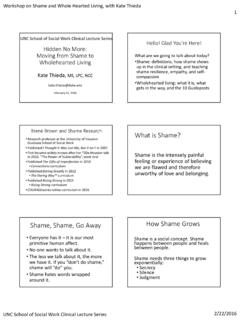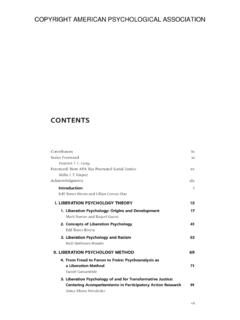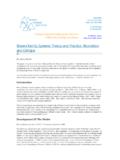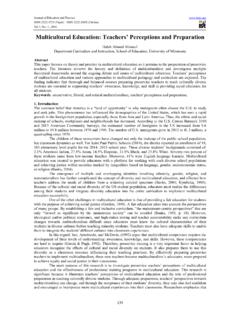Transcription of The Satir Growth Model: Theory and practice Jean McLendon ...
1 1 The Satir Growth Model: Theory and practice Jean McLendon , LCSW, LMFT Clinical Lecture Series School of Social Work University of North Carolina at Chapel Hill November 14, 2005 Professional and contact information: Jean McLendon , LCSW, LMFT 87 S Elliott Road, Suite # 212 Chapel Hill, NC 27514 919-967-2520 President, AVANTA: The Virginia Satir Network, Inc. Director of Training, Satir Systems Jean McLendon , mentored by family-therapy pioneer Virginia Satir , is recognized internationally as a leading Satir practitioner and trainer.
2 The Satir approach is central to Jean s work, whether she is working with individuals, couples, groups, or organizations. In addition to her own clinical practice , Jean has been involved in executive and leadership development training for over 30 years. She has traveled extensively, teaching therapists, managers, and consultants. Jean has also published widely on her approach. The heart of Jean's methodology is based on the belief that congruence is the single most powerful strategic intervention for changing the health, relationships and performance of individuals, families and organizations.
3 2 Satir Therapeutic Beliefs CHANGE is possible. Even if external change is limited, internal change is possible. PARENTS do the best they can at any given time. WE all have the internal resources we need to cope successfully and to grow. WE have choices, especially in terms of responding to stress instead of reacting to situations. THERAPY needs to focus on health and possibilities instead of pathology. HOPE is a significant component or ingredient for change. PEOPLE connect on the basis of being similar and grow on the basis of being different.
4 A major goal of therapy is to become our own choice makers. WE are all manifestations of the same life force. MOST people choose familiarity over comfort, especially during times of stress. THE problem is not the problem; coping is the problem. FEELINGS belong to us. We all have them. PEOPLE are basically good. To connect with and validate their own self-worth, they need to find their own inner treasure. PARENTS often repeat the familiar patterns from their growing up times, even if the patterns are dysfunctional.
5 WE cannot change past events, only the effects they have on us. APPRECIATING and accepting the past increases our ability to manage our present. ONE goal in moving toward wholeness is to accept our parental figures as people and meet them at their level of personhood rather than only in their roles. COPING is the manifestation of our level of self-worth. The higher our self-worth, the more wholesome our coping. HUMAN processes are universal and therefore occur in different settings, cultures, and circumstances.
6 PROCESS is the avenue of change. Content forms the context in which change can take place. CONGRUENCE and high self-esteem are major goals in the Satir model. HEALTHY human relationships are built on equality of value. Virginia Satir 3 Satir Recipe: To raise self-esteem for healing, learning, growing and changing at any system level: individuals, couples, families, groups, organizations, etc. Ingredients: (unique SELF with its special seasonings is essential) Resourcefulness Access self-esteem maintenance kit tools.
7 Empowerment Author new possibilities and choices. Congruence Connect from positive authenticity. Inner system Surface the inner essence which drives outside behaviors. Patterns Explore family of origin interpersonal patterns for coping w/ 7P s. Externalization Externalize inner world with multi-sensory methods (such as the mandala, self-esteem tools, ice-berg, ingredients of an interaction, copings, sculpting, to actualize Growth , and 7A s) Satir System Seven P s (primary interpersonal process pattern areas) 1.
8 PAIN: Grieving & Healing 2. PLEASURE: Celebrating & Recognizing 3. PROBLEMS: Learning & Changing 4. PLANS: Creating & Futuring 5. PERFORMANCE: Commitment & Competence 6. POWER: Energy & Connectivity 7. POSSIBILITY: Belief & Hope * Healthy process patterns promote: Understanding, Connection, Respect, and Trust * 4 Satir System Seven A s 1. Awareness Becoming aware of desire for change begins the cycle. 2. Acceptance Before we can make a meaningful change, we need to accept ourselves for who we are, appreciate our successes, and acknowledge that our copings arose as survival strategies.
9 3. Authorship Owning of our behaviors and choices. We author our life script and can therefore begin our change process right now. 4. Articulation With this step we make our intent to adopt new behaviors known to others. Sometimes, we ask others for help. 5. Application We identify opportunities, consider choices, and try out new ways of dealing with situations to practice new behaviors. 6. Activism Once we ve integrated our new behaviors, we begin to be able to recognize the desire for change in others and to offer support and guidance.
10 7. Altruism Building a solid and sustainable core foundation of care and congruence in our own life allows us to give from love by dipping into our unique and overflowing spiritual well. Process begins by fostering awareness, then adding safety and support to create the acceptance needed for catalyzing authorship. Ideas, feelings and behaviors can be articulated for support and further exploration. These new learnings can then be applied in one s life as needed and desired. Activism then emerges, than wholeness, not addiction and avoidance.













